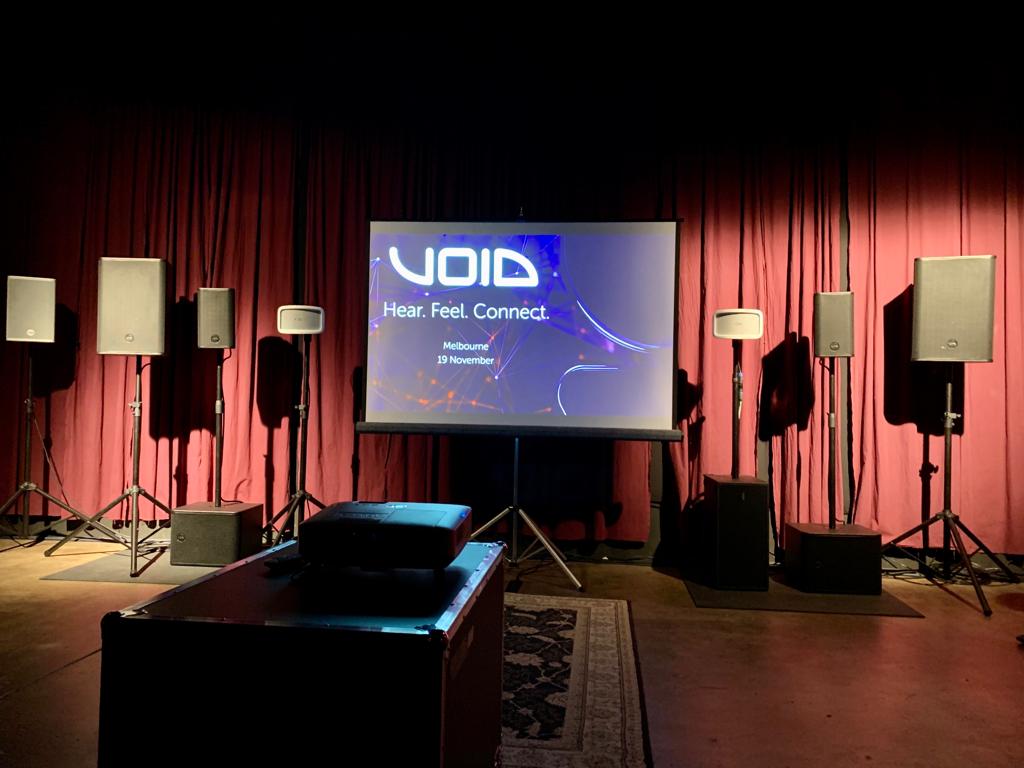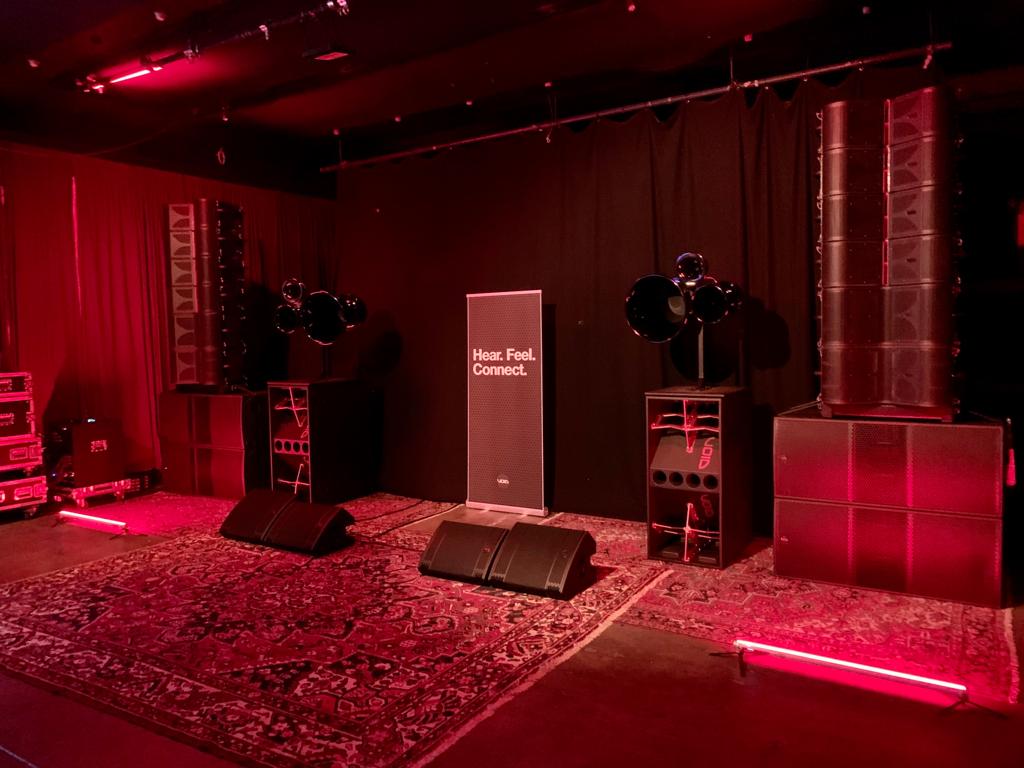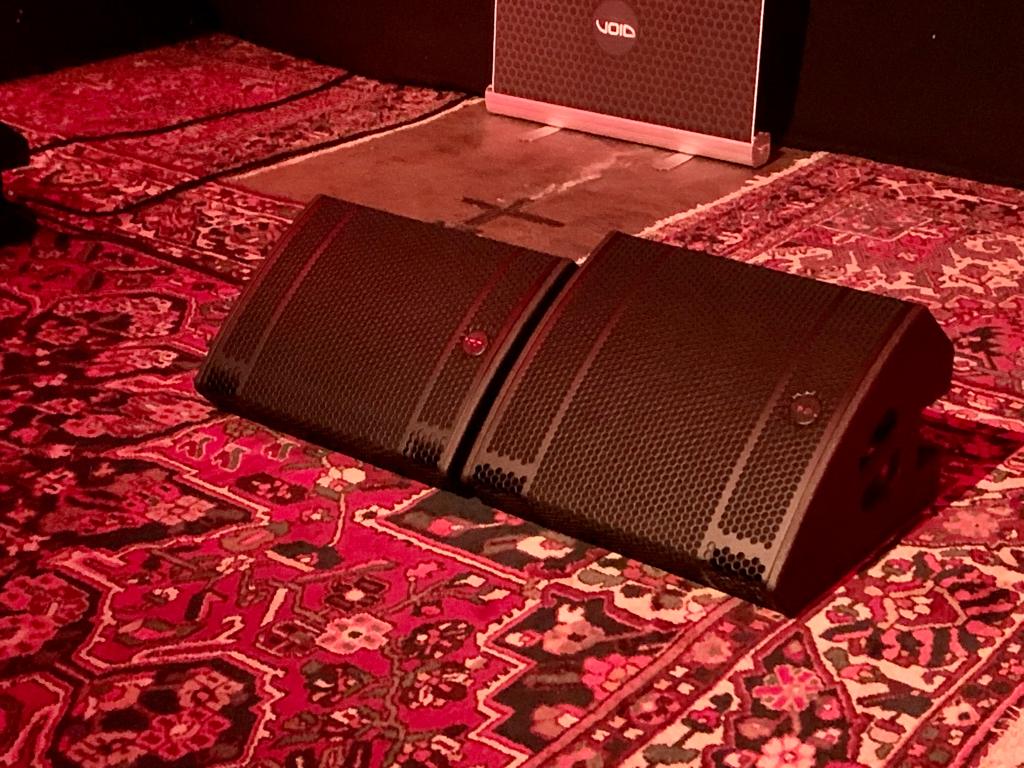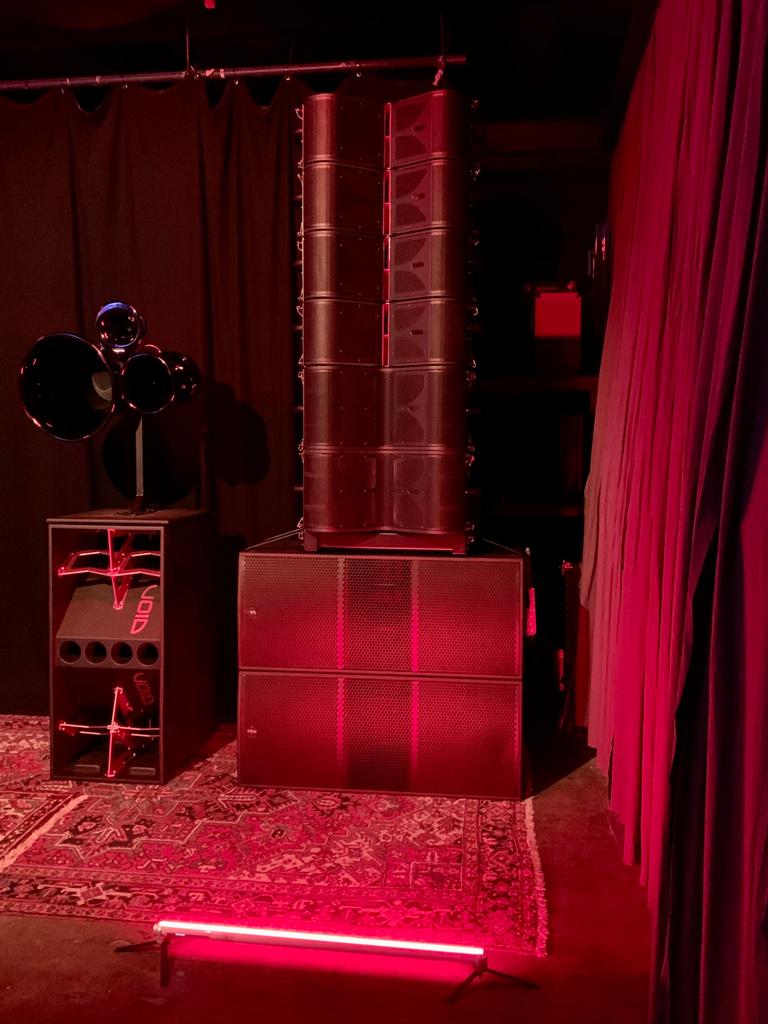Hi everyone,
While I was supposed to be helping my wife out with our new son, I escaped for a couple of hours to attend a demo afternoon for Void Acoustics, put on by Adam & Mark from Audiologistics, as well as Callum from Void in the UK.
Partly it was curiosity at the range, and partly it was to prove to myself that there are things louder than a baby bellowing for food. I was right.
(I’m sorry for the photo quality – check the product links in the text for much better photos)
Callum started talking about the Commercial range, but made the excellent point that just because a product falls in a particular category, it doesn’t mean you shouldn’t consider it for other job types.
Take the two Cyclone 55 speakers (left and right of the screen in the image above), paired with a Venu210i powered subwoofer. The Venu and Cyclone series both sit in their “Commercial” range. Those Cyclone 55 have two 5” drivers, marine-grade stainless steel fittings, wide dispersion, UV-resilient paint (custom paintable in any RAL tone for no extra cost, standard colours are black and white), IP55 rated and easy to install.
So, you could use a pair as weatherproof speakers in the outdoor area of a pub. Or on the deck of a yacht. Or in a café or restaurant, painted to match the restaurant’s colour scheme. Or… Or… Or…
The Venu 210i V2 is a powered dual 10” subwoofer, with an onboard 1200W amplifier not just for its own speakers, but to pass-through to two or four passive speakers via an output. So, we heard a 2.1ch configuration with two Cyclone 55 powered from the Venu210i. One extra note – a lot of venues don’t like having subs on the floor or built into the walls/desks/cupboards, so the entire Venu range can be rigged and flown, if required.
From a varied selection of demo tracks, the 2.1ch config here would be plenty for a small to medium size café, restaurant or a small bar. You could probably get away with it in a training room at a gym too. On the deck of a boat, or in a gallery, it’d be a great sounding system, even without the subs.
To the left and right of those were the Venu 8 V2 speakers, paired with two Venu 112 V2 passive subs. These would be a better choice for larger venues where more bass is needed. I can’t remember which of the Void Bias amplifiers they were using for the demo, but there was plenty of power on hand, and the speakers were clean. Version 2 of the original refined the design (less in-your-face), and a few tweaks to the mounting and connections.
Beyond those are a pair of Venu 15 V2, the newest and largest in the range. Before this, Venu stopped at 12” drivers (unsurprisingly named Venu 12 V2), but these 15” two-way speakers were a nice surprise for me. Typically, I haven’t liked 15” speakers for full-range sound, mainly because they tend to sound slow and heavy, with big gaps in the frequency response between 15” and treble driver. However, these were really listenable and a great choice for venues that just can’t have subwoofers around. Great choice for bars, small clubs, pubs, or for gyms that want to thump some bass without needing subs.
Next were the Air speakers, probably Void’s most well-known range due to their iconic design and club music credentials. In the photo above, you’ll see the Air Motion 3-way arrays (the black horn-looking things) over the top of the Stasys Xair 2×18” horn-loaded sub boxes (with the red/pink metal bracing frames in the middle). Typically you’d see these in nightclubs, bars, dance music events, that sort of thing. Again, don’t listen with your eyes and you’ll be surprised at how well these handle a range of music. Adam fired up “Take 5”, the classic jazz track from the Dave Brubeck Trio, and it was clean, delicate and perfectly reproduced. James Brown next, with serious funk and control. And yes, the drum & bass demo track that followed was clean and brutal, club sound at its best.
In front of those in the photo are the new ArcM 12 and ArcM 15 wedge speakers. These are a bit of a mixed-use product – traditional stage wedge for monitoring, pole-mount for front-of-house use, lightweight for touring, and more. With 500W of power handling, they’ll work hard for you in a lot of different spaces. My guess is that the touring and rental groups will love these for the flexibility. The dispersion was more narrow than some of the other speakers on demo, and if you were in the sweet spot for the 15” version, it was a full-on experience.
Lastly were the Arcline line array speakers. In the photo, you can see four of the Arcline 8 modules at the top, then two of the Arcline 212 below those, and two of the Arcline 218 touring subs at the bottom.
If you’re not familiar with line array speakers, they’re used to produce consistent sound levels from close up to far away from the speaker array. Think of a live stage where there might be people 30-100m or more away from the stage. Or a church with pews stretching from the front to the rear wall. The Arcline 8 and Arcline 212 modules can be both flown (i.e. hung from the ceiling) or stacked, like they were here on top of the subs. I can tell you that in our 25-30m demo for the day, you could walk side-to-side, front-to-back with your eyes closed and it’d be hard to tell how close you were to the speakers.
These systems have been used for venues like Ibiza Rocks (courtyard live/dance music in Spain) and a range of touring artists have used them too. As Callum described them, they’re not as touring-artist rider-friendly as some other brands, but they fit the same use cases and are perfect for jobs that don’t specify a brand. They have a range of features to make them easier to setup, both permanently and for touring groups.
One note with line arrays, as well as the conventional speakers – there is free software (Ease Focus 3) designed to estimate and model the performance of speakers in a space. You set room sizes, heights, and so on, then download the profiles for the speakers you plan to use, and take it from there. It’s mathematically challenging to design a line array system without using software to estimate the performance.
Adam fired the Arcline 8 + Arcline 212 up without the subs to start with, and they produced clean, clear and powerful sound. The bass levels were pretty impressive, but their clarity across the whole area on a variety of different music genres was really impressive.
And finally, Adam fired up the Arcline 218 subwoofers to go with the rest of the array. Holy moly, that was impressive in a 30m room! I’m willing to bet they were only at 5-10% of their capacity, but they had chest-crushing sound when they wanted to. Deadmau5 (dance music DJ who wears a mouse’s head) used the Arcline series for gigs in Berlin, and when Adam fired up that DJ’s track “Polaris”, you could understand why. I felt like I was back in uni and hearing house music for the first time. The bass is something you feel, like a giant hand squeezing you in time with the music!
OK, my final thoughts: My takeaway from the demos was mostly about judging a book by its cover, or a speaker by its looks.
Just because you can get a triple-driver AirMotion speaker array in shiny gold finish (oh yes, you can) doesn’t mean it won’t produce some of the most soulful jazz you’ve ever heard. Void has a well-deserved reputation as a club speaker brand, so banging sound in a gym or touring stage is well within their range. But if a high-end restaurant wants to have stunning sound, along with custom bare wood finish (of course that exists too), then Void & Audio Logistics will be my first call.
As we’d run out of warehouse space to keep all of these on hand, speak with one of our wholesale team if you want to know more about Void Acoustics: https://www.radioparts.com.au/trade. We’ve got other speakers in our PA range online here. And if you want to see how visually impressive their speakers can be, why not check out Void’s Instagram feed or Facebook pages. And of course, thanks to Audio Logistics for the demo day. Show them you care by checking out their Instagram and Facebook pages too.
Happy listening!
Cheers, Ben.



